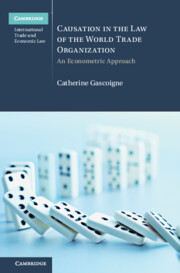Book contents
- Causation in the Law of the World Trade Organization
- Cambridge International Trade and Economic Law
- Causation in the Law of the World Trade Organization
- Copyright page
- Dedication
- Contents
- Figures
- Acknowledgements
- Table of Cases
- Table of Legal Instruments
- Abbreviations
- Introduction
- 1 Causal Theory
- 2 Trade Remedies
- 3 Serious Prejudice
- 4 Regulating for Non-trade Purposes
- 5 Retaliatory Measures
- Conclusion
- Bibliography
- Index
1 - Causal Theory
Published online by Cambridge University Press: 31 August 2023
- Causation in the Law of the World Trade Organization
- Cambridge International Trade and Economic Law
- Causation in the Law of the World Trade Organization
- Copyright page
- Dedication
- Contents
- Figures
- Acknowledgements
- Table of Cases
- Table of Legal Instruments
- Abbreviations
- Introduction
- 1 Causal Theory
- 2 Trade Remedies
- 3 Serious Prejudice
- 4 Regulating for Non-trade Purposes
- 5 Retaliatory Measures
- Conclusion
- Bibliography
- Index
Summary
Chapter 1 introduces the distinction between cause-in-fact and cause-in-law and defines both. Under ’cause-in-fact’, this chapter introduces different approaches to determining causation based on non-quantitative approaches (e.g., sine qua non and weak necessity/strong sufficiency tests) vis-à-vis quantitative approaches (e.g., the Statistical Significance Test and Linear Regression Analysis). The chapter also discusses the benefits and drawbacks of each of these tests. Chapter 1 also introduces the concept of ’cause-in-law’ theories, but explains why they are less relevant for the purposes of the book. To this end, it argues that the quantitative methods that are inherent in the use of the Tripartite Non-attribution/Causal Link Analysis serve to delimit responsibility for injury.
Keywords
- Type
- Chapter
- Information
- Causation in the Law of the World Trade OrganizationAn Econometric Approach, pp. 32 - 67Publisher: Cambridge University PressPrint publication year: 2023

